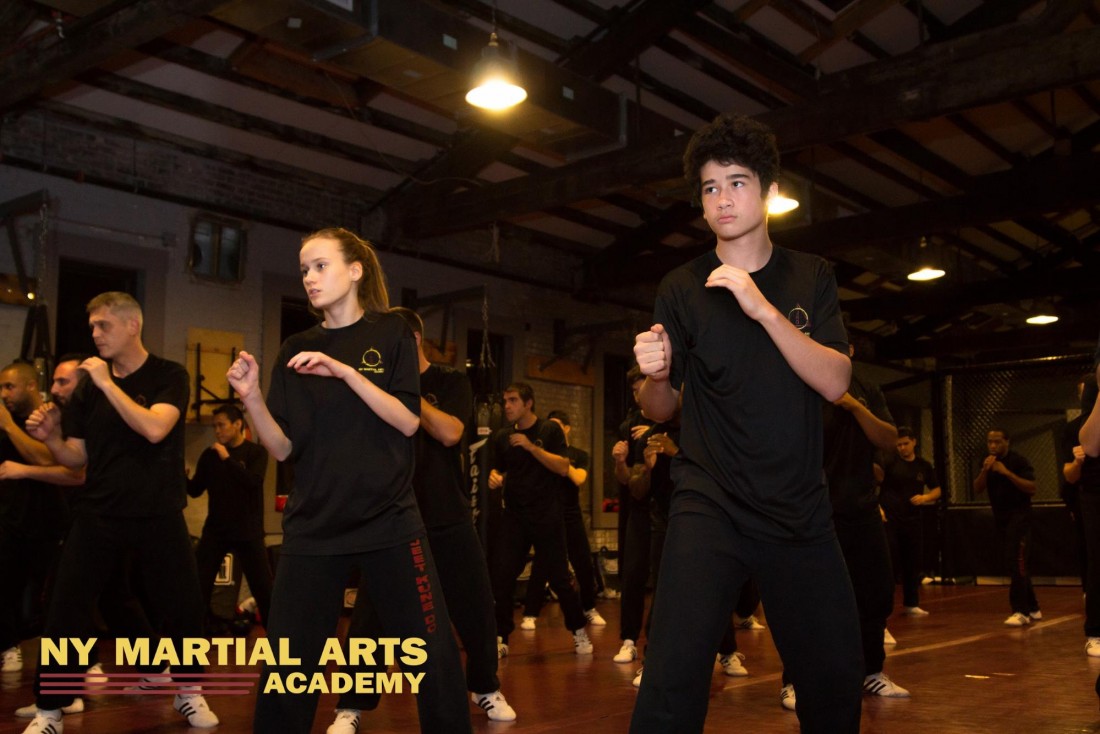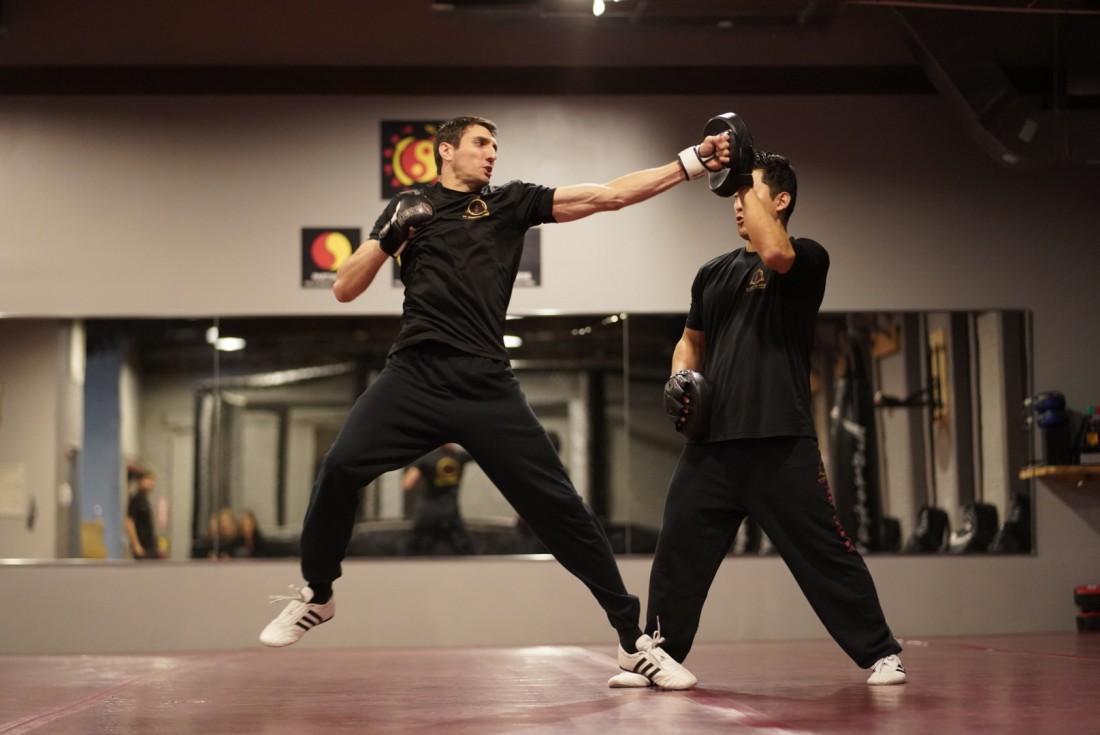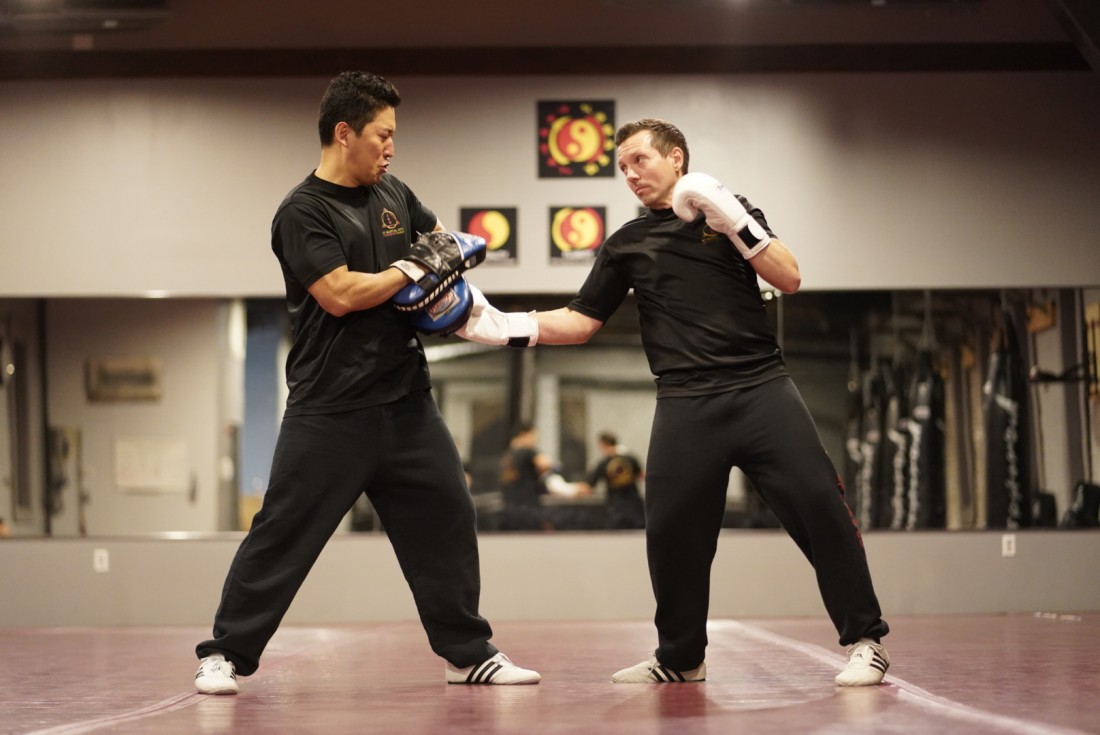The art of Jeet Kune Do created by Bruce Lee integrates all facets of combat. Various styles are borrowed from boxing, fencing, and other types of fighting. But one of the things that makes it truly unique is Jeet Kune Do footwork.
If you want to know how to avoid getting punched and have a better chance of landing your own strikes, proper foot placement will be pivotal to your success. This is where learning about the basic stance and practicing JKD footwork drills come into play.
Basic Jeet Kune Do Stance
By far, the most important step to proper footwork in Jeet Kune Do is knowing where to put your hands, body, and feet to start with. Before moving forward with drills or techniques, take a moment to perfect your JKD stance.

- Place your feet shoulder-width apart.
- Take a step forward with your strong-side foot.
- Ensure your front toe is lined up with your back heel.
- Your front foot should be angled at about 25 degrees.
- Your back foot angled at about 45 degrees.
- Bend your knees slightly and keep a light spring in your step.
- Your head should be directly over your pelvis
- Chin down with your eyes forward looking at your opponent.
t’s important to keep in mind that if your stance is too narrow, it will be much harder to attack with your rear hand or back foot. While on the other hand, with a stance that is too wide, you’ll become a bigger target and easier to hit in the body, face, or groin area. Keep your body at about a 45-degree angle with your opponent as often as possible.
Basic Jeet Kune Do Footwork Drills
Remember that you will never hop in JKD as this can easily make you lose your balance and control. Instead, proper footwork in Jeet Kune Do includes shuffling, stepping, and sliding your feet to find new angles.
All of the JKD drills below will begin from your basic stance.
Lead Step
Among the most simple footwork drills you can practice in JKD, the lead step has three variations: straight, left, and right. Your weight is pushed off your rear foot as you step forward with your lead foot while also throwing a punch. Straight lead step:
Straight lead step:
- Drive off your back foot, leaving it in place the duration of the move.
- Step your front foot forward while also throwing a straight punch with your lead hand.
- Immediately bring your lead foot back to your starting position.
Left lead step:
- Your opponent throws a straight punch.
- Slip outside their attack while doing a lead step to the left.
- Throw a punch with your lead hand at the same time you step, either with a high punch to the face or a low punch to the body.
- Bring your lead foot back to the starting position.
Right lead step:
- Your opponent throws a straight punch.
- Step inside their attack doing a lead step to the right.
- Throw a punch with your rear hand at the same time you step with a face or body shot.
- Slide your lead foot back to starting position.
The Shuffle
Also considered a standard head movement, the shuffle is a key type of JKD footwork for you to focus on. These moves allow you to either step away from your opponent when they attack or to step toward them with a counter.
- Your opponent throws a straight punch with either hand.
- Take a quick step back with your rear foot.
- Slip your lead foot back at the same time you step back.
- Lean your head back slightly to avoid a deeper punch.
Push Shuffle Forward:
- Drop your weight by bending your knees slightly.
- Lift your lead toe slightly and drive your weight forward from your rear leg.
- Slide your lead leg forward at the same time.
- Land heel to toe on the lead foot to stop your forward momentum.
When you are doing the push shuffle forward, you can also throw a quick straight punch or even strike with your elbow at the same time.
Drop Step
Using the drop step is a great way to learn how to avoid getting punched by your opponent’s rear hand. This Jeet Kune Do footwork also includes angling to the side while throwing your own punch as you step out of the way, whether your opponent is striking or not.
- Drive your weight to your lead foot while stepping your rear leg forward and to the outside.
- At the same time, throw a straight punch with your lead hand.
- With the new placement of your rear leg, return to your basic fighting stance with your front leg.
After you throw the first punch during your drop step, you can immediately follow it up with additional strikes such as a cross-hook combo.
Curve Step
The opposite of the drop step is the curve step, where you will now angle around your opponent moving your front leg first.

- Drive off your back foot stepping forward at a 45-degree angle with your front leg to your strong side.
- Throw a hook, uppercut, or a jab with your lead hand at the same time you are stepping away.
- Bring your rear leg forward to your regular fighting stance to match the new placement of your front leg.
Open Step
After you’ve practiced the previous moves a few times each, one of the more intermediate JKD footwork drills you can try is the open step. This movement involves moving both feet outward at the same time while also throwing a strike with your lead hand or elbow.
- As you bring your lead leg back slightly and to the side, drop your weight towards your rear leg.
- Immediately after, bring your rear leg forward and to the outside of your stance.
- Throw your punch with the lead hand at the same time as you move the rear leg.
- As you are throwing the strike with your lead hand, lean your body slightly in the same direction as your rear leg.
Proper Footwork is Critical to Jeet Kune Do
Knowing where to put your feet and when during a fight is going to make the difference and quickly decide who will have the upper hand.
There are many other aspects of effective JKD footwork including:
- Pendulum
- Angling
- Clock Pivot
- Circling
- Heel & Toe Sway
- Rocker Shuffle
- And more
As you learn these movements, you’ll be able to add strikes and also avoid getting punched or kicked.
Make sure you check out our full class on Jeet Kune Do footwork to learn more about the mechanics and benefits of these steps!
